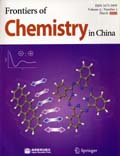Controlled-synthesis of ZnO nanorings
基本信息来源于合作网站,原文需代理用户跳转至来源网站获取
摘要:
ZnO nanorings were synthesized on a large scale by an easy solution-based method at 70℃ for 5 h using hexamethylenetramine (C6H12N4, HMT) and Zn ant poly(acrylamide-co-diallyldimethylammonium chlor-ide) (PAM-CTAC). The structure and morphology of the products were characterized by X-ray powder diffraction (XRD) and scanning electron microscopy (SEM). The influence of experimental conditions such as concentra-tion of surfactant and reactants, reaction temperature on the structure and morphology of the products were inves-tigated. A probable formation mechanism of ZnO nanor-ings in the presence of surfactant PAM-CTAC was discussed. The results show that the products are wurtzite hexagonal ZnO nanorings with an inner diameter of 220 nm and a wall thickness of 70 nm. Reaction temper-ature and concentration of reactants influence the shape and size ofZnO nanorings but PAM-CTAC plays the key role in the formation of ZnO nanorings. Through adjust-ing the concentration of PAM-CTAC, controlled-syn-thesis of ZnO nanorings can be realized. A room temperature photoluminescence (PL) spectrum of ZnO obtained shows that the full width at half maximum (FWHM) of the UV emission (~7 nm) is much narrower than that of commercial ZnO bulk crystals (~18 nm). The narrow FWHM confirms the uniformity and narrow size distribution of the synthesized ZnO crystals.

推荐文章
期刊_丙丁烷TDLAS测量系统的吸收峰自动检测
带间级联激光器
调谐半导体激光吸收光谱
雾剂检漏 中红外吸收峰 洛伦兹光谱线型
不同盐度、温度及光照对漂浮浒苔生理生态的影响
浒苔
盐度
温度
光照
生理生态
期刊_联合空间信息的改进低秩稀疏矩阵分解的高光谱异常目标检测
高光谱图像
异常目标检测 低秩稀疏矩阵分解 稀疏矩阵 残差矩阵
内容分析
关键词云
关键词热度
相关文献总数
(/次)
(/年)
文献信息
| 篇名 | Controlled-synthesis of ZnO nanorings | ||
| 来源期刊 | 中国高等学校学术文摘·化学 | 学科 | |
| 关键词 | zinc oxide controlled-synthesis nanoring | ||
| 年,卷(期) | 2008,(4) | 所属期刊栏目 | |
| 研究方向 | 页码范围 | 458-463 | |
| 页数 | 6页 | 分类号 | |
| 字数 | 语种 | 英文 | |
| DOI | 10.1007/s11458-008-0081-5 | ||
五维指标
引文网络
引文网络
二级参考文献 (15)
共引文献 (4)
参考文献 (16)
节点文献
引证文献 (0)
同被引文献 (0)
二级引证文献 (0)
1998(1)
- 参考文献(0)
- 二级参考文献(1)
2003(3)
- 参考文献(3)
- 二级参考文献(0)
2004(4)
- 参考文献(4)
- 二级参考文献(0)
2005(2)
- 参考文献(2)
- 二级参考文献(0)
2006(2)
- 参考文献(2)
- 二级参考文献(0)
2007(2)
- 参考文献(2)
- 二级参考文献(0)
2008(4)
- 参考文献(0)
- 二级参考文献(4)
2009(3)
- 参考文献(0)
- 二级参考文献(3)
2010(4)
- 参考文献(0)
- 二级参考文献(4)
2011(3)
- 参考文献(0)
- 二级参考文献(3)
2012(1)
- 参考文献(1)
- 二级参考文献(0)
2016(1)
- 参考文献(1)
- 二级参考文献(0)
2019(1)
- 参考文献(1)
- 二级参考文献(0)
2008(4)
- 参考文献(0)
- 二级参考文献(4)
- 引证文献(0)
- 二级引证文献(0)
研究主题发展历程
节点文献
zinc oxide
controlled-synthesis
nanoring
研究起点
研究来源
研究分支
研究去脉
引文网络交叉学科
相关学者/机构
期刊影响力
中国化学前沿
主办单位:
高等教育出版社
出版周期:
季刊
ISSN:
1673-3495
CN:
开本:
出版地:
北京市朝阳区惠新东街4号富盛大厦15层
邮发代号:
创刊时间:
语种:
eng
出版文献量(篇)
416
总下载数(次)
0
总被引数(次)
454
期刊文献
相关文献
推荐文献

 免费查重
免费查重










